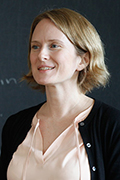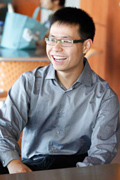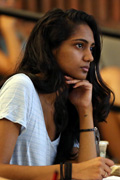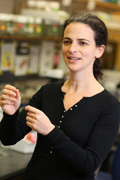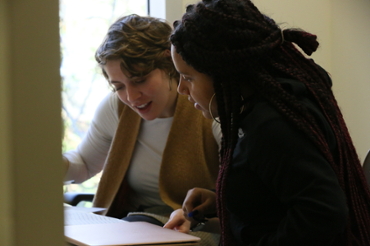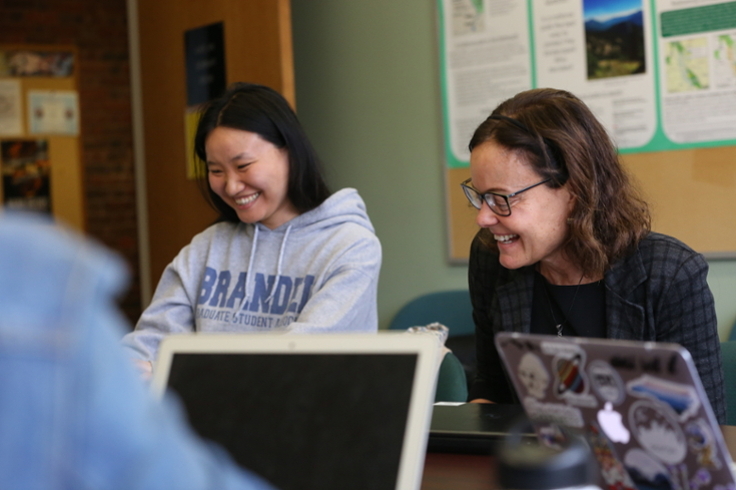English PhD Students Think Outside the Dissertation Box
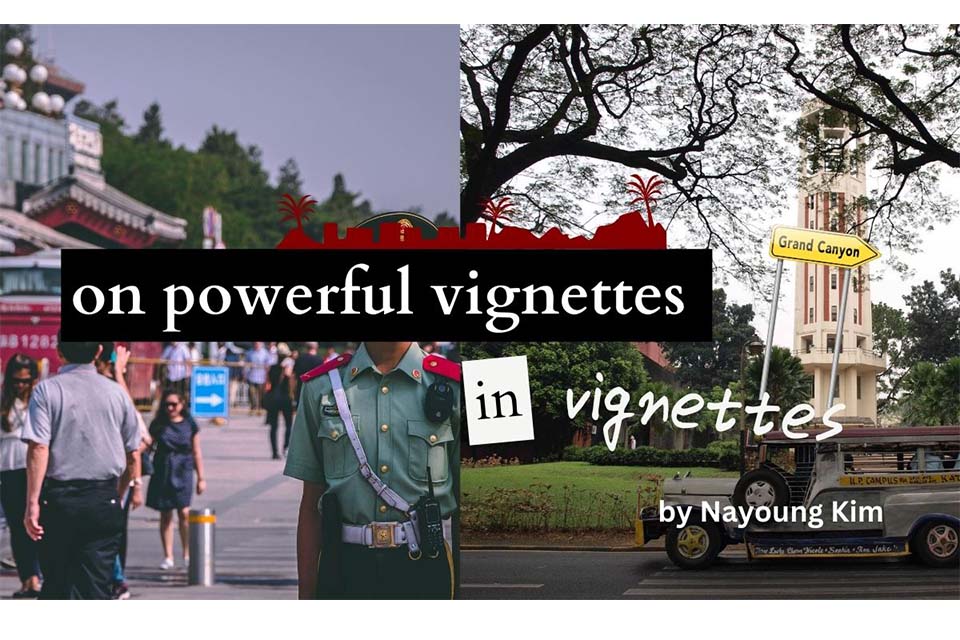
Photo Credit: Nayoung Kim
February 7, 2024
Abigail Arnold | Graduate School of Arts and Sciences
In the wake of 2020, responding to changes in the world and in academic job markets, Brandeis’s English faculty decided to change the structure and requirements of their PhD program. Among these changes? Allowing dissertations beyond the traditional book-length manuscript that the discipline usually demands. With the new curriculum coming into effect in 2021, the fruits of this change are now appearing in dissertations that take a wide range of forms.
Sixth-year PhD student Nayoung Kim was the first to complete a non-traditional dissertation, which she defended in December of 2023. Her dissertation is Prismatic Reader, an eye-catching website that combines analyses of contemporary novels with reflections on her own process and PhD program experiences, photographs and doodles, text in both English and Korean, and even a recording of her babbling baby. Kim said that, when coming up with the idea, “I wanted to think about how I communicate my content and the thoughts I have about my project. I wanted it to reach people easily and not be encased in ProQuest. I really wanted to be accessible to people, and a website is a super accessible medium.”
Kim found that thinking outside the box for her dissertation also meant challenging her own ways of thinking. When planning the website, she said, “It wasn’t a logical step by step but an accumulation of ideas. I mainly started with a concept and a color scheme that might go well with it and kind of tweaked it along the way. Everything was sprawled. It was an experiment and kind of a learning process–I’m an academic, and my brain is really coded to think in the chronological line-by-line way. Breaking away from that was really crucial to figuring out the entire thing.” In consequence, the Prismatic Reader website does not follow a linear structure but allows the reader to click around and select what they would most like to view. Individual pages link to others, and Kim tags smaller sections with terms like “Bits and Pieces” and “Moments.” She said, “I really wanted people to actually retrace my steps of making this entire project. You don’t necessarily have to start from an intro piece and work yourself through–you can pick and choose what interests you the most. I wanted to create a cluster of content that people can navigate freely.”
In addition, Kim worked to break down traditional distinctions between personal and academic life. She said that when thinking about where to add visuals to the website, “I tried to follow my own flow of thoughts, which are often quite spontaneous and more organic compared to when I set myself to write a traditional academic article. I wanted to follow the way my brain processes things–I was coming up with images on the spot while writing and thinking of how to incorporate them. This freed up my thinking and allowed me more wiggle room to incorporate some odd and seemingly unrelated images. It was very liberating and I really rejoiced in it.” Her choice to incorporate writing about her own experiences, such as in her essay about being a mother while writing a dissertation, combined a professional dimension of trying to convey a critical idea in which she is personally embedded and a personal dimension of seeking to refashion herself as a storyteller.
Other students in the English PhD program are currently finding their own ways to approach these questions of presenting their research and their own understanding of literary topics in new ways to new audiences. Sixth-year PhD student Sarah Perkins is working with a community in rural Idaho to create a film based on the story of Job. Like Kim, she brought together research interests and outside interests: she had been researching the Job narrative while in the program but also had previous experience working in documentary film (even before her Brandeis days) and knew that she was interested in continuing on that path. “I wanted to do something that would marry my research interests with film,” she said, “and I wanted to do docufiction and something more narrative.” When her mother’s childhood home in Idaho became available to rent, she took the opportunity to set her work in that community.
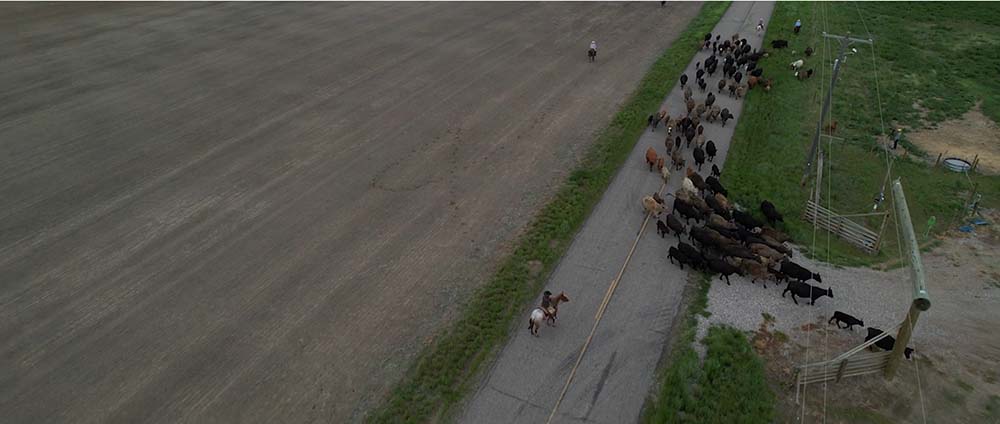
An image from Sarah Perkins's dissertation footage. Photo credit: Sarah Perkins.
For Perkins, one of the most interesting aspects of her project has been combining the academic approach with community-embedded work. Now having been in Idaho for about a year, she said, “I was excited about coming to a community that’s almost entirely disconnected from university spaces. People here are really intelligent and thoughtful, and less than three percent of them have a BA. They have really deep knowledge and modes of knowing that are disconnected from university research. I was excited about bridging that and bringing my knowledge to a community with a different approach and seeing what came of that.” The work of connecting with new people has been a big part of what she does; she said, “The people in this are our neighbors and people we’ve worked hard to connect with and be in a more authentic relationship with so they can trust us with stories from their lives and work.” Furthermore, the project has brought out some of the connections between different modes of communication and knowledge creation. Perkins said, “In the academic world, I think there’s this image of academic work as isolating: the genius working alone in their dark room with a computer and books. It’s not totally inaccurate, but film work depends on a community coming together to make it happen, and I think that’s accurate to academia as well. A cool aspect of this project has been to bring community to the fore more and acknowledge it.”
Another sixth-year PhD student, Yi He, is working to create an online course about the Puritans, aimed at young professionals. He’s own research focuses on Puritan media, which helped inspire the idea of creating a digital course. She said, “I am not personally a digital media-phile, but I really wanted to investigate newer media or technology devices.” She also felt that approaching her topic through the perspective needed to teach novices about it would help develop her own understanding. “Teaching gives you another angle to think about the Puritans,” she said. “When you teach, you can’t start with all the scholarly conversations, because frankly they’re not that interesting for students. So you have to research in a different way to teach the things that matter and help people understand history and their lives. Teaching is a way for you to learn and consider things–by the end of teaching something, you will yourself have figured out things.”
She also used pedagogical principles she had learned through her experiences at Brandeis when thinking about how to set up the course. She took a Learning Experience Design course through Rabb, funded by a Career Grant from the Mandel Center for the Humanities. Since she took the class around the same time she developed her dissertation prospectus, she was able to incorporate what she learned, including information about prototyping (the process of developing multiple iterations of the structure of course materials) and learning objectives. “As I’ve been developing this, I recently assigned learning objectives for each of my lectures. They really help you to focus what you’re doing because you have to have goals. It helped me identify that on a basic level, I just want to help students get a sense of who the Puritans were and how they ticked,” said He. Because she is also writing a series of essays, focused on angels in Puritan media, as a component of her dissertation, He is planning to use her course as a way to widen her focus. “The course is a way for me to understand the Puritans more and will give me a chance to explore questions about the role of Massachusett and Wampanoag people who interacted a lot with the Puritans and had their own media ecologies, which I don’t talk about as much in my essays,” she said. “The course lets me consider the media ecology more broadly, and the essays are a way to hone in. I highlight the same topic in different ways.”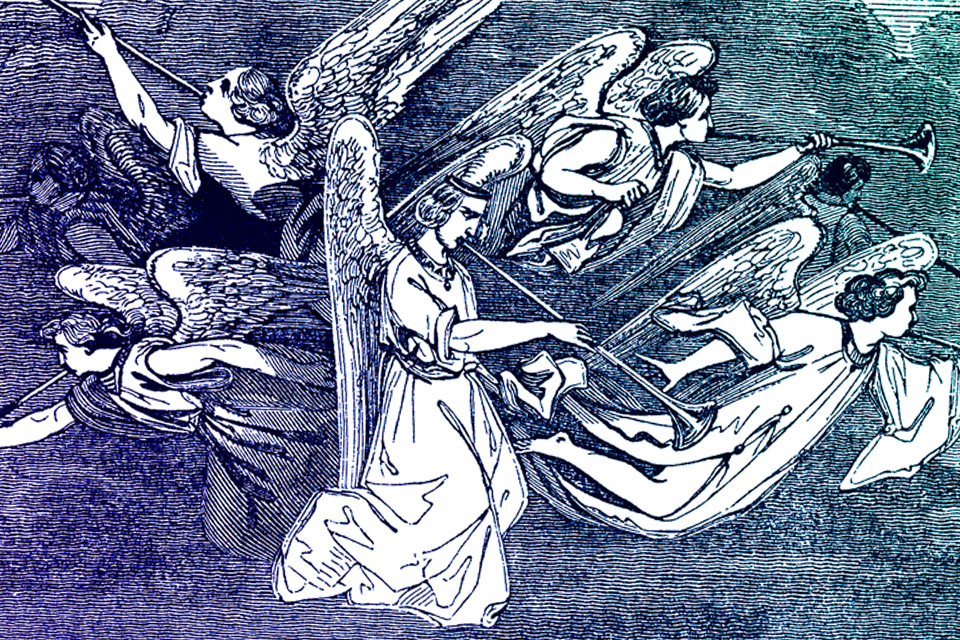
An 1837 woodcut of angels. Yi He discusses the Puritan media's portrayal of angels in her dissertation essays. Image credit: Getty Images.
In creating their non-traditional dissertations, all three considered the question of audience. Kim sees her audience as people who are interested in contemporary English language fiction and hopes to share new thoughts on these texts with them. “I’m hoping I can contribute a new line of interpretation for a body of very popular contemporary fiction, especially diaspora and environmental,” she said. “I wanted to offer a seed of different interpretations.” Perkins would like her dissertation to reach people beyond the academy. “I’m trying to make it more public-facing,” she said. “I think there’s space for dissertations that mostly live in the reading room and there’s a lot of utility and personal growth that comes from that, so I’m not discounting it. But I imagine this having a life beyond the experience of making.” And He hopes that her course will open opportunities for others’ learning. “I thought there wasn’t a way for young professionals who are working and have busy lives and maybe kids to learn about Puritans. There are short ten to fifteen minute lectures, and they’ll be on podcast platforms so people can listen easily. They can tailor it to what they’re doing and jump in at different places,” she said.
They also considered their place in the dissertation ecosystem and offered words of inspiration for others hoping to think outside the box in their own ways. “I hoped for more robust discussion about examples of nontraditional dissertation and how you do it, because I had a hard time navigating the resources,” said Kim. “I would like to initiate an ongoing conversation arena and start putting information there.” She did draw inspiration from Anna Williams’s My Gothic Dissertation podcast, which she said was “emotionally and mentally encouraging” in showing that a non-traditional dissertation was possible, and participated in a panel with Williams, organized by GSAS’s Jon Anjaria. Next-Generation Dissertations is another resource that He recommended as a place to find examples to study. “Be brave and plunge in!” He said. “When it’s not established, it feels different, but it’s really worthwhile. It makes you grow a lot.”
Perkins emphasized the need to build one’s dissertation around one’s own interests. “If you’re working on something that you care a lot about, it’s going to be a lot easier to do the project,” she said. “Maybe you care about reading and writing literary criticism–then do that! But maybe you care about music or public arts projects. Think about what about them fascinates you and lights you up. Dissertation projects take a lot of work, so try to make sure you’re doing something that will bring you energy and happiness.” Kim agreed that the dissertation project is ultimately a personal one. “I would recommend thinking about your values first. By values, I mean something that can be non-negotiable,” she said. “For me, I realized that was inserting or reflecting on my experience as a person in my critical practice. I’d forgotten about that for a long time, and it was really crucial to insert back into the project. The rest–the medium and theme–came out of that.” As they move into the future of dissertation writing (or filming, coding, designing, and even more), Brandeis’s English PhD students are reflecting on themselves and their personal and academic goals to produce meaningful work for others.
